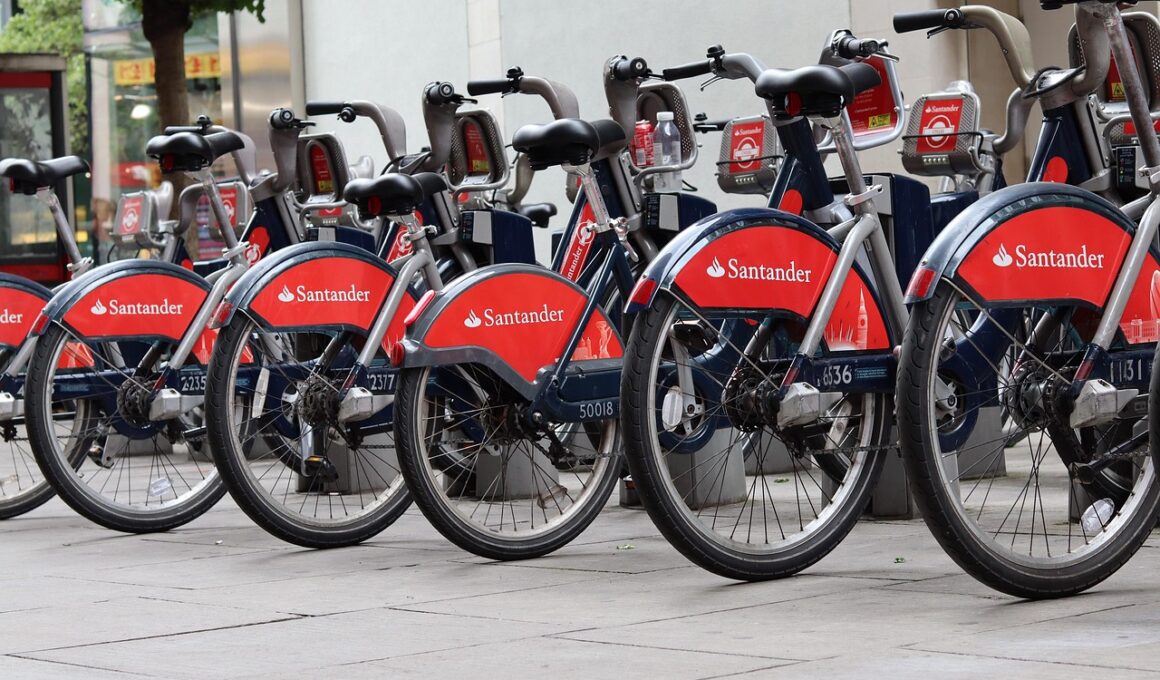Urban Cycling and Public Transportation Integration
Urban cycling plays a vital role in modern city commuting, offering a flexible and efficient mode of transportation. As cities grapple with soaring population densities and increasing traffic congestion, the integration of cycling with public transportation systems becomes paramount. Commuters benefit greatly from a seamless transition between biking and traditional transport options. Enhanced infrastructure, such as bike lanes, secure bike parking at transit hubs, and reliable bike-sharing programs, is essential for this integration. Some cities provide subsidized bike rentals for transit users, making urban cycling more appealing than ever. Furthermore, local governments can foster partnerships with bike-sharing companies to streamline services. More so, public awareness campaigns can educate residents about the advantages of cycling, which include reduced travel time and lower carbon emissions. By showcasing the positive impacts of cycling on urban environments, cities can encourage a shift towards healthier, more sustainable commuting habits. Therefore, investing in cycling infrastructure is not merely an option; it’s integral to addressing urban challenges in the 21st century. With the right commitment, urban cycling can significantly alleviate transportation issues faced in metropolitan areas, ultimately benefiting all urban dwellers.
Integration of cycling and public transport systems allows for several advantages to both cyclists and cities. One major benefit is the enhanced connectivity between urban districts, which encourages more people to pedal rather than drive. A well-structured transport network helps reduce reliance on cars, promoting sustainability in urban centers. Additionally, reducing vehicular traffic leads to decreased air pollution, improving overall public health. Cities can significantly boost cycling by investing in safe bike lanes that connect to public transportation hubs. Also, improving infrastructure with bike racks and maintenance stations can help increase bicycle usage for daily commutes. Studies reveal that cities implementing these strategies experience higher rates of cycling adoption. Riders who feel secure and welcomed are more likely to choose bicycles over less sustainable options. Local governments must prioritize the creation and maintenance of cycling paths that are well marked and illuminated, especially during evening hours. Moreover, integrating technology, such as mobile apps for route planning that include cycling paths, can enhance the experience for users. With these initiatives, urban cycling stands to revolutionize how cities approach the future of public transit.
Challenges Facing Urban Cycling Integration
Despite the promising potential of urban cycling, several challenges remain that mitigate its growth. One significant hurdle is the lack of cohesive urban planning, which often fails to prioritize cycling as a viable mode of transport. Many cities have disjointed cycling paths that do not connect to public transport systems, leaving cyclists exposed to dangerous roads. There’s also the issue of road safety, as accidents involving cyclists and motor vehicles can deter individuals from cycling altogether. Improving infrastructure alone isn’t enough; cities must also educate drivers about sharing the road responsibly. Besides, public perceptions about cycling hazards can significantly impact participation rates. Commuters hesitant to bike due to safety concerns are less likely to incorporate cycling into their daily routines. Furthermore, inclement weather poses another barrier for many urban cyclists, as adverse conditions discourage cycling. Cities could offer incentives such as sheltered bike parking or climatic accommodations for everyday riders. Innovative solutions to these obstacles are necessary to create a balanced urban transportation ecosystem that fully utilizes the benefits of cycling alongside public transport systems.
One key approach towards improving urban cycling infrastructure is through community engagement and advocacy. Cycling advocates can play a pivotal role in driving change within city planning departments. Through organized campaigns and community workshops, these groups can help raise awareness about the importance of integrating cycling with public transport. Inviting input from local cyclists ensures that infrastructure plans address the actual needs within the community. Collaborative efforts between cycling advocacy organizations and government entities can lead to significant improvements in local cycling conditions. Gathering cyclist testimonials can further strengthen the case for better infrastructure. When city planners recognize the real-world challenges faced by cyclists, they can design safer roadways and intersections. Public meetings can also create a platform where stakeholders voice their concerns and expectations. Correspondingly, educational programs can train both drivers and cyclists to practice mutual respect on shared roads. Local governments can thus develop cycling-friendly policies based on participatory dialogues. Acknowledging the ideas and experiences of the cycling community will ensure that urban planning evolves and adapts effectively, fostering an inclusive environment that appreciates diverse commuting methods.
Successful Case Studies in Urban Cycling
Many cities worldwide have successfully integrated urban cycling into their public transportation systems, showcasing innovative solutions that enhance commuting experiences. For instance, Copenhagen has effectively linked its cycling network with public transport, making it easy for riders to transition between modes. More than 62% of the city’s residents regularly commute by bike, thanks in part to extensive bike lanes and the prioritization of cyclists in urban planning. Similarly, Amsterdam has become a beacon for cycling culture, where bicycles often outnumber cars. This city offers free bike parking facilities near public transport hubs, minimizing the hassle of finding secure storage. Wellington in New Zealand has also made strides by implementing detailed cycling maps and educational campaigns promoting bike safety. Each of these examples illustrates that a committed approach to cycling infrastructure encourages more residents to cycle, contributing positively to city transportation systems. Moreover, adopting technology, such as real-time tracking for public transport combined with cycling paths, enhances user convenience. Ultimately, these case studies serve as valuable lessons for other cities looking to replicate their success in urban cycling integration.
As cities cautiously progress towards a greener future, fostering an inclusive approach towards cycling must be prioritized. Collaborations amongst government agencies, businesses, and the community at large can enhance urban cycling initiatives. Incentives such as subsidies for bike purchases and the incorporation of cycling classes can further motivate residents. Acknowledging the role of local businesses in supporting cyclists, such as providing discounts for bike commuters, creates a mutually beneficial scenario. Additionally, infrastructure investments yield economic advantages and can attract new residents and businesses. Citizens feeling secure while cycling will likely take to their bicycles more often, resulting in reduced traffic congestion. With every pedal stroke taken by a commuter, urban areas see a decrease in emissions, fostering cleaner environments. Furthermore, by improving urban cycling connectivity to public transport, residents can access their workplaces more conveniently. Overall, even small changes in policies can significantly enhance support for cycling, ultimately benefiting cities economically and environmentally. As urban cycling gains momentum, city planners and transportation officials must remain adaptive, responding creatively to the evolving demands of urban dwellers.
Future Perspectives on Urban Cycling
In looking ahead, urban cycling integration promises to remain crucial for sustainable city development. As technology advances, cities can expect improved resources for cyclists, including better mapping applications, bike-sharing technology, and integrated transport systems. Smart city initiatives can merge cyclists’ data with public transport patterns to optimize routes for maximum efficiency. As electric bikes grow in popularity, urban cycling becomes accessible to a wider audience, encouraging further participation. Innovative solutions like bike highways can build dedicated routes connecting urban centers, effectively enabling a robust cycling culture. Moreover, integrating electric vehicle charging stations with bike-sharing points can create multimodal transport hubs. Alongside, public transport providers will likely enhance their infrastructure to accommodate bicycles more readily. Assessing current facilities, cities can work to create policies that align closely with the needs of cyclists. This continuous evaluation will ensure urban cycling systems remain efficient and user-friendly. Ultimately, fostering a widespread cycling culture promotes not only healthier lifestyles but also lays the groundwork for a sustainable future within the urban landscapes we inhabit.
In conclusion, the integration of urban cycling and public transportation offers vast potential for enhancing urban mobility. By creating an environment that fosters cycling, cities can tackle numerous problems related to traffic, pollution, and health. This integration requires strategic planning, investment in infrastructure, and community involvement. When local governments prioritize cycling, they create a ripple effect that positively influences the community. Successful case studies from around the globe exemplify the benefits of implementing such strategies effectively. As urban populations continue to grow, it is vital that cities embrace cycling not just as a mode of transport but as a vital component of urban life. Furthermore, the future promises exciting advancements in technology that can support urban cycling. As cities become more adaptable to these changes, urban cycling can emerge as a sustainable solution to our mass transit woes. Committed partnerships between various stakeholders will ensure the continuous evolution of urban cycling. If done correctly, this will ultimately foster healthier, happier urban dwellers. In turn, this synergy contributes significantly to more livable and sustainable cities where cycling and public transport work in tandem.


